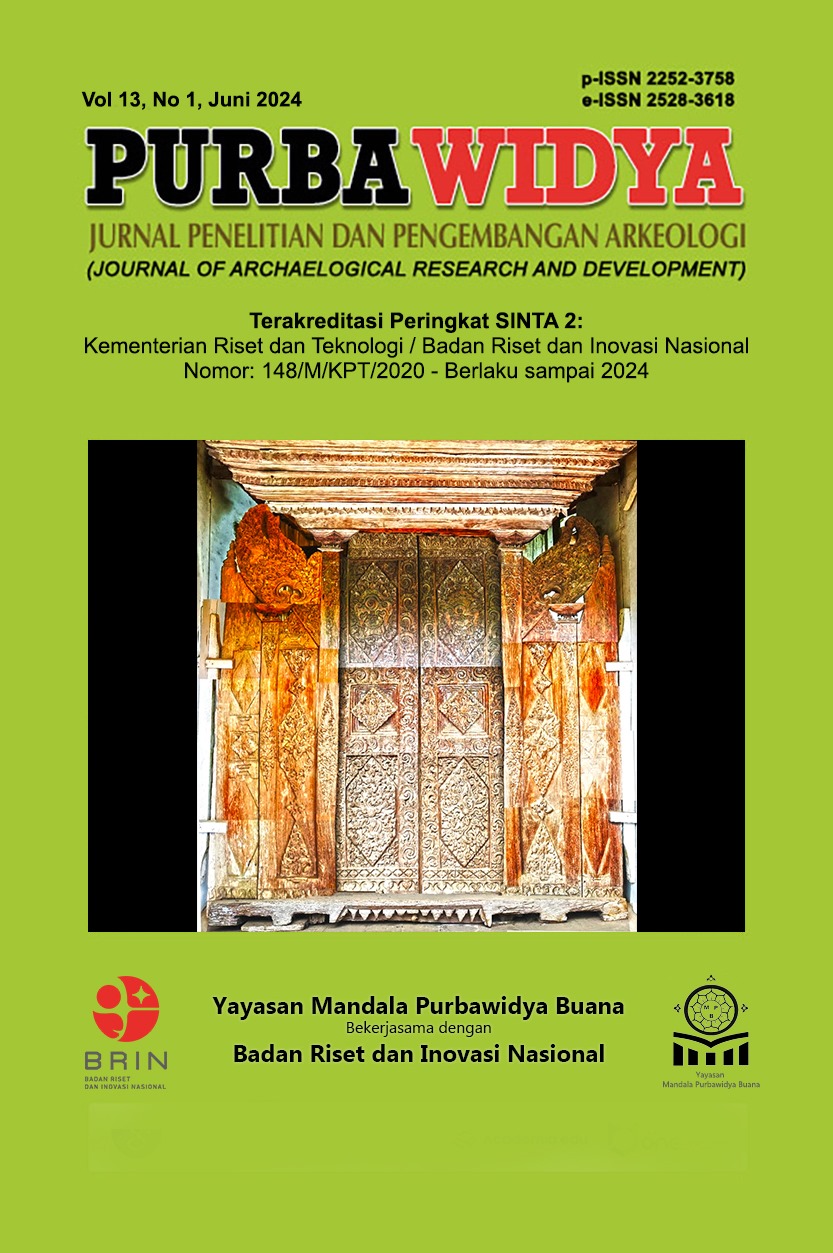Perahu dan Rumah Gadang Bagian Budaya Kayu di Sekitar Danau Singkarak, Sumatera Barat
Main Article Content
Abstract
The environment of Lake Singkarak provides natural resources to be utilized by human around it by providing facilities that support their lives. In the water area, of course, boats are needed as a mode of transportation for fishermen. Likewise, markers of settled life in the form of settlements with traditional buildings including ‘Rumah Gadang’. This paper uses qualitative methods with inductive reasoning flows. Data was collected on primary (through observation, observation of object and environment, in-depth interviews) and secondary data. The steps in qualitative research are data collection, analysis, and data synthesis. The purpose of writing is to find out about the sustainability of wood culture on the shores of Lake Singkarak and the local wisdom of the community. The change in manufacture and utilization from dugout canoes to plank boats is an adaptation strategy to the scarcity of sources of Surian wood tree materials. The developed buildings and ornaments also depict the complexion of maritime life (in the lake environment). Nature is a source of inspiration in its motifs and coloring, such as the motif of ‘pucuak rabuang’ (young bamboo), flowers, leaves, fish, and the Dutch royal crown. This is a form of local wisdom of the community in adapting to environmental conditions.
Article Details

This work is licensed under a Creative Commons Attribution-NonCommercial-ShareAlike 4.0 International License.
Authors who publish with this journal agree to the following terms:
- Authors retain copyright and grant the journal right of first publication with the work simultaneously licensed under Creative Commons Attribution-NonCommercial-ShareAlike 4.0 International License that allows others to share the work with an acknowledgement of the work's authorship and initial publication in this journal.
- Authors are able to enter into separate, additional contractual arrangements for the non-exclusive distribution of the journal's published version of the work (e.g., post it to an institutional repository or publish it in a book), with an acknowledgment of its initial publication in this journal.
- Authors are permitted and encouraged to post their work online (e.g., in institutional repositories or on their website) prior to and during the submission process, as it can lead to productive exchanges, as well as earlier and greater citation of published work (See The Effect of Open Access).
References
Abdullah, Maulana, Antariksa, and Noviani Suryasari. 2015. “Pola Ruang Dalam Bangunan Rumah Gadang Di Kawasan Alam Surambi Sungai Pagu – Sumatera Barat.” Arsitektur.Studentjournal.Ub.Ac.Id 3 (1): 1–9.
Amzy, Nurulfatmi. 2017. “Analisis Makna Ornamen Rumah Gadang Dalam Perspektif Filsafat Pendidikan.” Jurnal Desain 4 (3). DOI: 10.30998/jurnaldesain.v4i03.1465
Badan Pusat Statistik Kabupaten Solok. 2021. Solok Dalam Angka. Kayu Aro: BPS Kabupaten Solok. https://solokkab.bps.go.id/publication.html.
Badan Pusat Statistik Kabupaten Tanah Datar. 2021. Kabupaten Tanah Datar Dalam Angka Tanah Datar. BPS Kabupaten Tanah Datar. https://tanahdatarkab.bps.go.id/publication.html.
Faturahman, Muhammad Azhar, Muhammad Yusfado A H, and Silvia Rini Putri. 2021. “Rumah Gadang Sebagai Lambang Demokrasi Suku Minangkabau Di Sumatera Utara.” Soshum Insentif 4 (1): 54–59.
Fitriza, Rozi. 2018. “Model Transfer Pengetahuan Arsitektur Tradisional Rumah Gadang Minangkabau.” Teorema 2 (2): 73–84.
Habibi, Gantino. 2018. Rumah Gadang Yang Tahan Gempa. Badan Pengembangan dan Pembinaan Bahasa.
Halim, Khaterine Steffi, and Eveline C S. 2006. “Peranan Ruang Pada Rumah Gadang Di Sumatera Barat.” Dimensi 6 (2). DOI: 10.25105/dim.v6i2.1145.
Hidayat, Herry Nur. 2018. “Pengembangan Motif Ukiran Rumah Gadang Untuk Motif Kain: Revitalisasi Dan Pengembangan Industri Kreatif.” Lingua Idea 9 (1).
Kristiawan, Nana. 2017. Pola Adaptasi Ekologi Budaya Tiga Komunitas di Jambi. Bhumi, Jurnal Agraria dan Pertanahan 3 (2): 189. DOI: 10.31292/jb.v3i2.124.
Mantani, Khairat, and Muhammad Fauzan. 2019. “Desain dan Analisis Struktur Bangunan Adat Sumatera Barat Terhadap Ketahanan Gempa.” JSIL Jurnal Teknik Sipil Dan Lingkungan 4 (1): 25–36 . DOI: https://doi.org/10.29244/jsil.
Nabawi, Rahmat Aziz, Syahril, Aprizal Saputra, Salmat, and Arya Zulhendrik. 2021. “Studi Susunan Lapisan Serat Penguat Yang Idela Untuk ‘Biduak’ Perahu Tradisional Minangkabau.” Sains Dan Teknologi Keilmuan Dan Aplikasi Teknologi Industri 21 (2): 326–34.
Neuman, W. Lawrence. 2014. Pearson New International Edition, Qualitative and Quantitative Approaches. Sevent. England: Pearson Education Limited. p 204-5.
Shalika, Mayang Putri, Robert Sibarani, and Eddy Setia. 2020. “Makna Ornamen Rumah Gadang Minangkabau: Kajian Semantik.” Humanika 7 (2): 70-81. DOI: 10.14710/humanika.v27i2.32594.
Steward, H. J. 1955. Theory of Culture Change. London (US): Univ of Illinois Pr.
Susilowati, Nenggih dkk. 2021. Laporan Penelitian Arkeologi. Mencari Jejak Hunian Prasejarah pada Situs-Situs Terbuka di Sekitar Tepian Danau Singkarak, Sumatera Barat. Balai Arkeologi Provinsi Sumatera Utara.
Susilowati, Nenggih, Taufiqurrahman Setiawan, dan Gilang Aditya. 2023. "Environmental Study for the Conservation of the Simawang Megalitic Site, Lake Singkarak, West Sumatera". IOP Conf. Series: Earth and Environmental Science 1188 (2023) 012036. IOP Publishing. doi:10.1088/1756-1315/1188/1/012036.
Tanudirjo, Daud Aris. 1989. “Ragam Penelitian Arkeologi Dalam Skripsi Karya Mahasiswa Arkeologi Universitas Gadjah Mada”. Laporan Penelitian. Fakultas Sastra Universitas Gadjah Mada.
Tim Penyusun. 1998. Ukiran Tradisional Minangkabau. Departemen Pendidikan dan Kebudayaan Direktorat Jendral Kebudayaan.
Zein, Anastasha. 2017. Ruang Komunal pada Arsitektur Vernakular Uma, Lamin, dan Rumah Gadang. Jurnal ATRAT V5/N3/09/2017.

